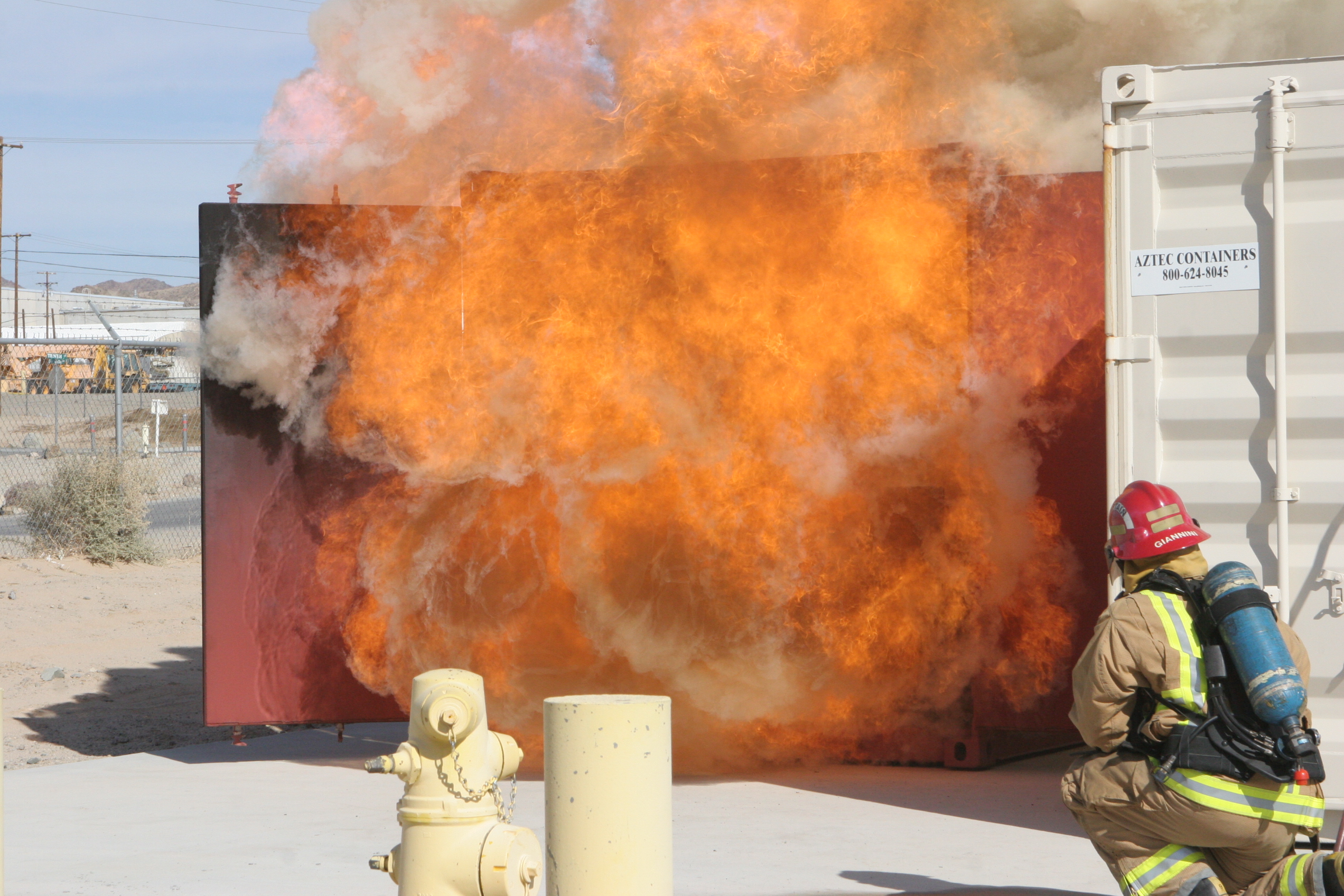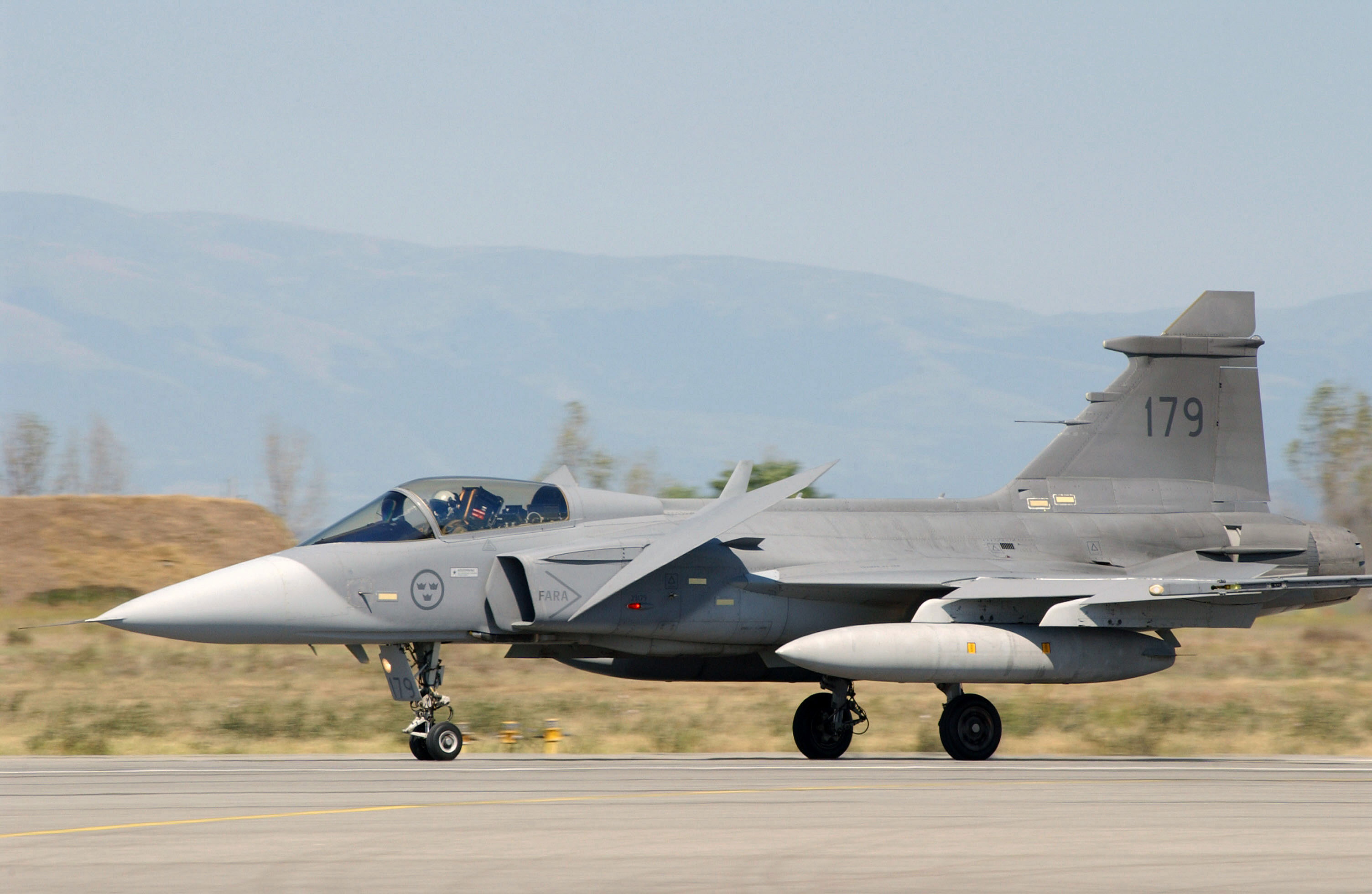|
Cutting Extinguisher
The use of a cutting extinguisher is a fire extinguishing technique that combines abrasive waterjet cutting with water spray extinguishing, through a single handpiece or nozzle. The fire-fighter approaches the fire from outside the main fire area, then uses the cutting action to drill a small hole through a door or wall. Switching to a water spray then allows the fire to be fought, as with a conventional fog nozzle. The main advantages of this system are in increased safety for the firefighter, as they remain outside the most hazardous area. In particular, the need for highly-dangerous smoke diving is reduced. The small size of the access hole also reduces any risk of flashover or backdraft. Flashover is reduced by avoiding the need to open up a large access hole, while backdraft is reduced by the flow of water through this small hole keeping any flow cooled and directed inwards, towards the fire. Secondary advantages are in gaining rapid access to the seat of the fire, directly ... [...More Info...] [...Related Items...] OR: [Wikipedia] [Google] [Baidu] |
Fire Extinguisher
A fire extinguisher is a handheld active fire protection device usually filled with a dry or wet chemical used to extinguish or control small fires, often in emergencies. It is not intended for use on an out-of-control fire, such as one which has reached the ceiling, endangers the user (i.e., no escape route, smoke, explosion hazard, etc.), or otherwise requires the equipment, personnel, resources, and/or expertise of a fire brigade. Typically, a fire extinguisher consists of a hand-held cylindrical pressure vessel containing an agent that can be discharged to extinguish a fire. Fire extinguishers manufactured with non-cylindrical pressure vessels also exist but are less common. There are two main types of fire extinguishers: stored-pressure and cartridge-operated. In stored pressure units, the expellant is stored in the same chamber as the firefighting agent itself. Depending on the agent used, different propellants are used. With dry chemical extinguishers, nitrogen is typ ... [...More Info...] [...Related Items...] OR: [Wikipedia] [Google] [Baidu] |
Fog Nozzle
A fog nozzle is a firefighting hose spray nozzle that breaks its stream into small droplets. By doing so, its stream achieves a greater surface area, and thus a greater rate of heat absorption, which, when compared to that of a smoothbore nozzle, speeds its transformation into the steam that smothers the fire by displacing its oxygen. Specially designed fog nozzles (with no stream adjustment) have been certified by Underwriters Laboratories (UL) for use on Class B & C hazards. Roles Fog nozzles play an important part in firefighting tactics due to their versatility. The wide variety of fog nozzle manufacturers allows them to accommodate different sizes of fire hose—most often attack hand line—and streams and are capable in both fire protection and attack. With regard to flow rate, it is imperative to be sure that each fog nozzle be able to handle the flow rate of its water supply because the master stream devices to which they are sometimes attached can expel up to per m ... [...More Info...] [...Related Items...] OR: [Wikipedia] [Google] [Baidu] |
Smoke Diving
Smokejumpers are specially trained wildland firefighters who provide an initial attack response on remote wildland fires. They are inserted at the site of the fire by parachute. In addition to performing the initial attack on wildfires, they may also provide leadership for extended attacks on wildland fires. Shortly after smokejumpers touch ground, they are supplied by parachute with food, water, and firefighting tools, making them self-sufficient for 48 hours. Smokejumpers are usually on duty from early spring through late fall. Smokejumpers worldwide Smokejumpers are employed by the Russian Federation, United States (namely the United States Forest Service and Bureau of Land Management), and Canada (in British Columbia). History Prior to the full establishment of smokejumping, experiments with parachute insertion of firefighters were conducted in 1934 in Utah and in the Soviet Union. Earlier, aviation firefighting experiments had been conducted with air delivery of equipme ... [...More Info...] [...Related Items...] OR: [Wikipedia] [Google] [Baidu] |
Flashover
A flashover is the near-simultaneous ignition of most of the directly exposed combustible material in an enclosed area. When certain organic materials are heated, they undergo thermal decomposition and release flammable gases. Flashover occurs when the majority of the exposed surfaces in a space are heated to their autoignition temperature and emit flammable gases (see also flash point). Flashover normally occurs at or for ordinary combustibles and an incident heat flux at floor level of . An example of flashover is the ignition of a piece of furniture in a domestic room. The fire involving the initial piece of furniture can produce a layer of hot smoke, which spreads across the ceiling in the room. The hot buoyant smoke layer grows in depth, as it is bounded by the walls of the room. The radiated heat from this layer heats the surfaces of the directly exposed combustible materials in the room, causing them to give off flammable gases, via pyrolysis. When the temperatures of th ... [...More Info...] [...Related Items...] OR: [Wikipedia] [Google] [Baidu] |
Backdraft
A backdraft (North American English) or backdraught (British English) is the abrupt burning of superheated gasses in a fire, caused when oxygen rapidly enters a hot, oxygen-depleted environment; for example, when a window or door to an enclosed space is opened or broken. Backdrafts present a serious threat to firefighters. There is some debate concerning whether backdrafts should be considered a type of flashover (see below). Burning When material is heated enough, it begins to break down into smaller compounds, including hydrogen. This is called pyrolysis, and does not require oxygen. If oxygen is also provided, then the hydrogen can combust, starting a fire. If material undergoing pyrolysis is later given sufficient oxygen, the hydrogen gas will ignite, and therefore, combustion takes place. Cause A backdraft can occur when a compartment fire has little or no ventilation. Due to this, little or no oxygen can flow into the compartment. Then, because fires reduce oxygen, ... [...More Info...] [...Related Items...] OR: [Wikipedia] [Google] [Baidu] |
Rescue Services Agency (Sweden)
The Swedish Rescue Services Agency (SRSA) ( sv, Statens räddningsverk (SRV)) was the central supervisory government agency for the rescue services in Sweden until 2008, after which it merged into the newly formed Swedish Civil Contingencies Agency on January 1, 2009. It promoted emergency management practice that improved disaster prevention and response, and in the event of an incident/accident limited injury and damage. This was achieved among other ways by conveying information, by running training courses and holding exercises, and through supervision. Government function The SRSA was the central Swedish supervisory government authority for the rescue services. Its tasks included examining co-ordination between the various branches of the national rescue services, as well as contingency planning by the county administrative boards for the rescue services in the event of a release of radioactive substances. The agency also collated observations and lessons learned from serious ... [...More Info...] [...Related Items...] OR: [Wikipedia] [Google] [Baidu] |
Swedish Civil Contingencies Agency
The Swedish Civil Contingencies Agency ( sv, Myndigheten för samhällsskydd och beredskap, ) is a Swedish administrative authority, organised under the Ministry of Justice. The agency is responsible for issues concerning civil protection, public safety, emergency management and civil defence. Responsibility refers to measures taken before, during and after an emergency or crisis. MSB work in close cooperation with the municipalities, the county councils, other authorities, organisations and the private sector to achieve increased safety and security at all levels of society. This is done through education, support, training exercises, regulation and supervision. The agency covers the whole spectrum of contingencies; from everyday road traffic accidents and fires, up to chemical emergencies, power cuts and other technical failures. Additionally, more serious emergencies, such as bomb threats and other antagonistic attacks, epidemics, natural disasters and war. In most cases, the re ... [...More Info...] [...Related Items...] OR: [Wikipedia] [Google] [Baidu] |
Saab Group
Saab AB (originally , later just SAAB and Saab Group) is a Swedish aerospace and defence company, founded in 1937. Headquartered in Stockholm, the development and the manufacturing is undertaken in Linköping. Saab produced automobiles from 1947 until 1990 when the automobile division was spun off as Saab Automobile, a joint venture with General Motors. The joint venture ended in 2000 when GM took complete ownership. From 1968 onwards the company was in a merger with commercial vehicle manufacturer Scania-Vabis, known as Saab-Scania. The two were de-merged in 1995 by the new owners, Investor AB. Despite the demerger, both Saab and Scania share the right to use the griffin logo, which originates from the coat of arms of the Swedish region of Scania. History "Svenska Aeroplan AktieBolag" (Swedish for "Swedish Aeroplane Company Limited") (SAAB) was founded in 1937 in Trollhättan, with the merger of Svenska Aero AB (SAAB) and Linköping based ASJA the headquarters moved to Linköp ... [...More Info...] [...Related Items...] OR: [Wikipedia] [Google] [Baidu] |
Thermal Imaging Camera (firefighting)
A thermal imaging camera (colloquially known as a TIC) is a type of the thermographic camera used in firefighting. By rendering infrared radiation as visible light, such cameras allow firefighters to see areas of heat through smoke, darkness, or heat-permeable barriers. Thermal imaging cameras are typically handheld, but may be helmet-mounted. They are constructed using heat- and water-resistant housings, and ruggedized to withstand the hazards of fireground operations. While they are expensive pieces of equipment, their popularity and adoption by firefighters in the United States is increasing markedly due to the increased availability of government equipment grants following the September 11 attacks in 2001. Thermal imaging cameras pick up body heat, and they are normally used in cases where people are trapped where rescuers cannot find them. Construction A thermal imaging camera consists of five components: an optic system, detector, amplifier, signal processing, and di ... [...More Info...] [...Related Items...] OR: [Wikipedia] [Google] [Baidu] |
Ventilation (firefighting)
Ventilation is a part of structural firefighting tactics, and involves the expulsion of heat and smoke from a burning building, permitting the firefighters to more easily and safely find trapped individuals and attack the fire. If a large fire is not properly ventilated, it is much harder to fight, and can build up enough poorly burned smoke to create a smoke explosion or enough heat to create a flashover. Poorly placed or timed ventilation can increase the fire's air supply, causing it to grow and spread rapidly. Flashover from inadequate ventilation can cause the temperature inside the building to peak at over . Types of ventilation In general, there are two types of ventilation; vertical and horizontal. Their names refer to the general locations of the intended exit points of the heat and smoke to be ventilated. Vertical ventilation takes place through holes cut in the roof, typically by truck companies during the early stages of a fire in a process known collectively as roo ... [...More Info...] [...Related Items...] OR: [Wikipedia] [Google] [Baidu] |






